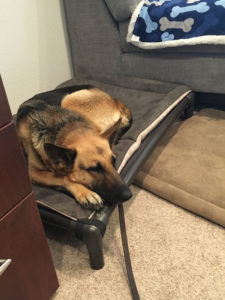FROM THE BEGINNING: Bringing Your New Furry Friend Home
 First Steps When Bringing Your Pet Home…
First Steps When Bringing Your Pet Home…
In this issue, we continue our conversation about what to do when first bringing your new dog home and we want to make sure we “set the right tone”. Remember, your new dog is coming into your home with no knowledge of the rules of your house. Now is the time to decide how you want things to be and “set the right tone” to achieve this goal.
No one wants to have to scold or get frustrated with their dog, especially their new furry friend that just came home with them! The easiest way to avoid this is to keep your new dog on a 6 foot leash for the first couple of weeks when in the home. If he is on a leash and with you, he can’t get into the trash, pull a shoe from the closet, urinate in the corner behind the recliner or get immediately rewarded with your turkey sandwich that he snatched off the kitchen countertop. Having him close by allows you to observe his actions and quickly interrupt/stop any behavior you don’t want him to do. More importantly, it allows you to reward the good behaviors that he begins to show you. For example, you look down and he is quietly sitting watching you. Mark that awesome behavior and give him a small treat. The more you can reinforce the behaviors you want and prevent the behaviors you don’t want, the quicker you start to see the dog you are desiring.
Now is the time to decide things like do we want the dog on the furniture? Will we feed him from the table? What should we do when it is time to go outdoors? Where will he be when he is left home alone? Most of these have to do with setting boundaries for our dogs and most of us have a hard time doing this. The important thing to remember is – it is always easier to be strict at the beginning and then loosen the rules later than the other way around!
Let’s start with furniture. There is more to consider here than whether or not you want to contend with the dog hair on the upholstery. Being up on the furniture can become a symbol of being in charge for some dogs. It can be fun to be comfy and cozy on the couch with your dog and for some dogs, it has no effect on their behavior. But for other dogs, being on the furniture including in the human’s bed can create a serious problem. Best advice is don’t allow him/her on the furniture….you can change that rule later if things are going well.
Feeding from the table, the counter top, the grill! Should you do it? Ask yourself if you want your dog to be under your feet as you try to prepare a meal, sitting by your dinner guests begging during a meal, or trying to snatch a burger from the grill when you turn your back. You have probably answered “NO” so start now and just DON’T do it.
It is time to go outdoors, you open the door and your dog goes racing out when you barely have it open. Is this what you want? Probably not, so start now and teach your dog to respect the door threshold. We will cover the training method in a future issue but for now, keep your dog on his leash when you open the door and don’t allow him to go out until you go out first.
It is Monday and work is calling. The kids are headed to school, you are headed to work and no one will be home with the new pup. What to do? Training your new dog to stay in a crate while you are gone is one of the best things you can do. You may be lucky and find out your new rescue pup is already crate trained but if not, this should be one of the first things on your list of things to work on. While some people find it offensive to think of a dog being confined to a crate for any period of time, most dogs find their crate to be a place of security and peace. Once trained to the crate, some will opt to go there even when their humans are home as they find it comforting.
Remember, setting the tone is so important and the sooner you can do it with your dog, the better. We wanted to get your wheels turning about this topic in this issue and in subsequent issues, we will be giving you detailed steps you can take to achieve some of these goals – like working on thresholds, crate training, and rewarding behaviors appropriately. Now, grab your leash and take that new pup for a walk!!
